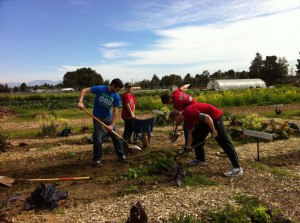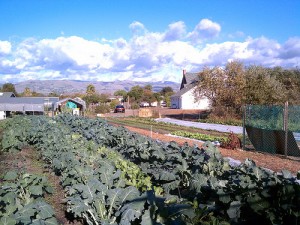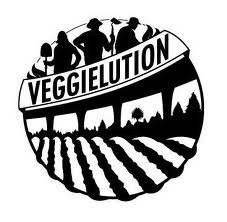The key litmus test of a good professional conference for me is this: are there cool field trips planned? If the answer is yes, the gathering is likely to be an enjoyable and fruitful occasion. That was definitely the case at the Association for Environmental Studies and Sciences conference this past weekend in California, where I went on a bus and walking tour of two urban farms in the Silicon Valley: Full Circle Farm in Sunnydale (near Santa Clara), and Veggielution Community Farm in San José. Both are quite large operations by urban farm standards, but like many such sites are relatively young in age and still under development.
Full Circle Farm is intriguing for a number of reasons. At ten acres, the farmstead is huge — walking the grounds you have an expansive view of the sky and feel the freedom of being in a large swath of open land — something rather different from most small gardens and farms that are hemmed in with the urban built environment.
The farm is located on grounds owned by the local school district: formerly a football field, the land now belongs to an adjacent middle school, which leases the property to the Full Circle Farm non-profit organization in exchange for free educational programming for the school district. (The precise and somewhat complex terms of the lease are now up for renegotiation, something fairly typical for urban farm operations.) The farm is incredibly diverse: it has plot after plot of veggies and herbs, of course, but also free-roaming chickens, a children’s garden, a huge community garden area run by volunteers, a large outdoor theater (!), and more.

One fascinating thing that happened while we were there was an up-close wildlife encounter: a juvenile red-tailed hawk flew around and perched near us for several minutes. It was trying to hunt some recently fledged killdeer in a plowed field, something the parent killdeer weren’t too pleased about; while unsuccessful in her hunt, perhaps due to the fussing of the parent killdeer, the hawk taught us an important urban ecology lesson: a farm of this scale, and probably one considerably smaller, can provide critical habitat for wildlife in the city and suburban landscape, and thus contribute to the conservation of biodiversity (in addition to all the other incredible functions of these spaces).
The other farmstead we visited was in San José, in the midst of a largely Hispanic community of limited means and with great need of access to fresh, healthy food. Hence the mission of Veggielution Community Farm, which aims to “build community[,] . . . embrace diversity[,] . . . empower youth[, and] . . . create a sustainable food system.” At two acres under cultivation, this farm started back in 2008 as a humble community garden plot within an existing city parkland — the Emma Prusch Farm Park — that itself was donated to San José by a forward-thinking woman who decided that agricultural land preservation in the fast-urbanizing Silicon Valley was more important than selling her property to developers. Current plans call for significantly expanding the farm’s operation within several more acres they have leased from the park district.

An intriguing features of Veggielution Community Farm is its location: right along the soaring and rather imposing structure of a long, curving highway entrance ramp — a landscape feature that is highlighted in their official logo. But looking in the other direction with the roar of the highway at your back, you can see mountains in the not-too-far distance along the suburban horizon (as shown at left). To a native Midwesterner, this was a visually dramatic location to observe the typical on-the-ground activities of an urban farm.
My big takeaway from visiting these urban farms in Silicon Valley, a place simultaneously of great wealth and of considerable need among the less-fortunate population? Large-scale farms such as these are impressive for a number of reasons, and incredible diverse and multifaceted in their outreach to and impact upon the community.  They also, like most urban farms, plunge forward despite heavy reliance upon volunteer labor (and even volunteer management, to some degree), regular turnover among staff (such as the 1-2 year rotations by AmeriCorps workers, who are an amazing and vital human resource here), and razor-thin budget margins. They have the benefit of a year-round growing season, yes, but must import all of their water because the region is so dry. And they combine the production of good food with exuberant cultural activities and positive and progressive community development. They are thus places of magic and inspiration — and hope for a more sustainable food production system in suburban ecosystems.
They also, like most urban farms, plunge forward despite heavy reliance upon volunteer labor (and even volunteer management, to some degree), regular turnover among staff (such as the 1-2 year rotations by AmeriCorps workers, who are an amazing and vital human resource here), and razor-thin budget margins. They have the benefit of a year-round growing season, yes, but must import all of their water because the region is so dry. And they combine the production of good food with exuberant cultural activities and positive and progressive community development. They are thus places of magic and inspiration — and hope for a more sustainable food production system in suburban ecosystems.
Here in the Midwest, the heart of the heartland, we’re making strides with urban farming — especially in big cities like Chicago, Milwaukee, and Detroit. But the smaller cities and suburbs have a lot of catching up to do. That’s OK, but we should get going soon. For while our growing season here in Illinois is shorter than that of CA, we’ve got good land to work and/or reclaim — and abundant precipitation to feed our crops (this dry spring and early summer excepted). And as for people in need of work, inspiration, education, and healthy food? Yeah, we’ve got them in abundance.